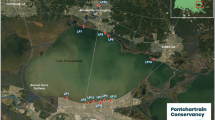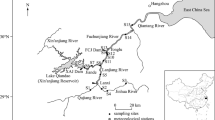Abstract
In late May, 2007, a drinking water crisis took place in Wuxi, Jiangsu Province, China, following a massive bloom of the toxin producing cyanobacteria Microcystis spp. in Lake Taihu, China’s third largest freshwater lake. Taihu was the city’s sole water supply, leaving approximately two million people without drinking water for at least a week. This cyanobacterial bloom event began two months earlier than previously documented for Microcystis blooms in Taihu. This was attributed to an unusually warm spring. The prevailing wind direction during this period caused the bloom to accumulate at the shoreline near the intake of the water plant. Water was diverted from the nearby Yangtze River in an effort to flush the lake of the bloom. However, this management action was counterproductive, because it produced a current which transported the bloom into the intake, exacerbating the drinking water contamination problem. The severity of this microcystin toxin containing bloom and the ensuing drinking water crisis were attributable to excessive nutrient enrichment; however, a multi-annual warming trend extended the bloom period and amplified its severity, and this was made worse by unanticipated negative impacts of water management. Long-term management must therefore consider both the human and climatic factors controlling these blooms and their impacts on water supply in this and other large lakes threatened by accelerating eutrophication.





Similar content being viewed by others
References
Albay M, Akcaalan R, Tufekci H, Metcalf JS, Beattie KA, Codd GA (2003) Depth profile of cyanobacterial hepatotoxins(microcystins) in three turkish freshwater lakes. Hydrobiologia 505(1–3):89–95
Alonso-Andicoberry C, Garcia-Villada L, Lopez-Rodas V, Costas E (2002) Catastrophic mortality of flamingos in a Spanish national park caused by cyanobacteria. Veterinary Record 151(23):706–707
Bates BC, Kundzewicz ZW, Wu S, Palutikof JP (eds) (2008) Climate change and water, technical paper of the intergovernmental panel on climate change. IPCC Secretariat, Geneva, 210 pp
Carmichael WW (2001) Health effects of toxin producing cyanobacteria: the cyanoHABs. Human Ecological Risk Assessment 7:1393–1407
Carmichael WW, Azevedo MFO, An JS, Molica RJR, Jochimsen EM, Lau S (2001) Human fatalities from cyanobacteria: chemical and biological evidence for cyanotoxins. Environmental Health Perspectives 109(7):663–668
Chen W, Song LR, Peng L, Wan N, Zhang XM, Gan NQ (2008) Reduction in microcystin concentrations in large and shallow lakes: Water and sediment-interface contributions. Water Research 42:763–773
Chen YW, Qin BQ, Teubner K, Dokulil MT (2003a) Long-term dynamics of phytoplankton assemblages: Microcystis-domination in Lake Taihu, a large shallow lake in China. Journal of Plankton Research 25:445–453
Chen YW, Fan CX, Teubner K, Dokullil M (2003b) Changes of nutrients and phytoplankton chlorophyll-a in a large shallow lake, Taihu, China: an 8-year investigation. Hydrobiologia 506(509):273–279
Codd GA, Bell SG, Kaya K, Ward CJ, Beattie KA, Metcalf JS (1999) Cyanobacterial toxins, exposure routes and human health. European Journal of Phycology 34:405–415
Duan H, Ma R, Xu X, Kong F, Zhang S, Kong W, Hao J, Shang L (2009) Two decade reconstruction of algal blooms in China’s Lake Taihu. Environmental Science and Technology 43:3522–3528
Fogg GE (1969) The physiology of an algal nuisance. Proceedings of the Royal Society London B 173:175–189
Guo L (2007) Doing battle with the green monster of Lake Taihu. Science 317:1166
Hawkins PR, Runnegar MT, Jackson AR, Falconer IR (1985) Severe hepatotoxicity caused by the tropical cyanobacterium (blue-green alga) Cylindrospermopsis raciborskii (Woloszynska) Seenaya and Subba Raju isolated from a domestic water supply reservoir. Applied Environmental Microbiology 50:1292–1295
Hu WP, Zhai SJ, Zhu ZC, Han HJ (2008) Impacts of the Yangtze River water transfer on the restoration of Lake Taihu. Ecological Engineering 34(1):30–39
Huang WY, Xu G, Wu QL, Qin BQ (2008) Pollution and eutrophication. In: Qin BQ (ed) Lake Taihu, China, dynamics and environmental change. Springer Science+Business Media B.V., pp 23–42
Hudnell HK (2008) Cyanobacterial harmful algal blooms-state of the science and research needs. Proceedings of the interagency, international symposium on cyanobacterial harmful algal blooms. RTP North Carolina, Sept. 2005. Advances in experimental medicine and biology, vol 619, 949 pp. Springer Science.
Intergovernmental Panel on Climate Change (IPCC) (2007) Climate change 2007: the physical science basis. In: Solomon S, Qin D, Manning M (eds) Contribution of working group I to the fourth assessment report of the intergovernmental panel on climate change. Cambridge University Press, Cambridge, UK
James RT, Havens K, Zhu GW, Qin BQ (2009) Comparative analysis of nutrients, chlorophyll and transparency in two large shallow lakes (Lake Taihu, P.R. China and Lake Okeechobee, USA). Hydrobiologia (in press)
Jöhnk KD, Huisman J, Sharples J, Sommeijer B, Visser PM, Stroom JM (2008) Summer heatwaves promote blooms of harmful cyanobacteria. Global Change Biology 14:495–512
Kouzminov A, Ruck J, Wood SA (1996) New Zealand risk management approach for toxic cyanobacteria in drinking water. Australian and New Zealand Journal of Public Health 31(3):275–281
Li W, Zhang CK, Wang RY (2007) A numerical storm surge model based on unstructured meshes and finite volume method. Journal of Tropical Oceanography 26(2):9–14 (in Chinese)
Lin YD, Yu SZ, Xu M, Yang JB, Chen Y, Hu L (2003) A study on the relationship between Wuxi Taihu waters pollution by algae toxin and health of the population. Shanghai Journal of Preventitive Medicine 15:435–437 (in Chinese)
Murphy T, Lawson A, Nalewajko C, Murkin H, Ross L, Oguma K, McIntyre T (2000) Algal toxins - Initiators of avian botulism? Environmental Toxicology 15:558–567
National Climatic Data Center (2007) Climate of 2007—February in historical perspective. http://www.ncdc.noaa.gov/oa/climate/research/2007/feb/feb07.html
National Research Council (NRC) (2000) Clean coastal waters: understanding and reducing the effects of nutrient pollution. National Academy Press, Washington, DC
National Research Council (NRC) (2006) Surface Temperature Reconstructions For the Last 2, 000 Years. National Academy Press, Washington, DC
Paerl HW (1988) Nuisance phytoplankton blooms in coastal, estuarine, and inland waters. Limnology and Oceanography 33:823–847
Paerl HW, Fulton RS (2006) Ecology of harmful cyanobacteria. In: Graneli E, Turner J (eds) Ecology of harmful marine algae. Springer-Verlag, Berlin, pp 95–107
Paerl HW, Huisman J (2008) Blooms like it hot. Science 320:57–58
Pu P, Yan J (1998) Taihu Lake–a large shallow lake in the East China plain. Journal of Lake Sciences (China) 10(suppl):1–12
Pyo D, Jin J (2007) Production and degradation of cyanobacterial toxin in water reservoir, Lake Soyang. Bulletin of Korean Chemistry Society 28(5):800–804
Qin BQ, Xu PZ, Wu QL, Luo LC, Zhang YL (2007) Environmental issues of Lake Taihu, China. Hydrobiologia 581:3–14
Saker ML, Thomas AD, Norton JH (1999) Cattle mortality attributed to the toxic cynaobacterium Cylindrospermopsis raciborskii in an outback region of North Queensland. Environmental Toxicology 14(1):179–182
Shen PP, Shi Q, Hua ZC, Kong FX, Wang ZG, Zhuang SX (2003) Analysis of microcystins in cyanobacteria blooms and surface water samples from Meiliang Bay, Taihu Lake, China. Environment International 29:641–647
Song LR, Chen W, Peng L, Wan N, Gan NQ, Zhang XM (2007) Distribution and bioaccumulation of microcystins in water columns: A systematic investigation into the environmental fate and the risks associated with microcystins in Meiliang Bay, Lake Taihu. Water Research 41:2853–2864
Teixera MGLC, Costa MCN, Carvalho VLP, Pereira MS, Hage E (1993) Gastroenteritis epidemic in the area of the Itaparica Dam, Bahia, Brazil. Bulletin of Pan American Health Organization (PAHO) 27(3):244–253 (1993)
Van Ginkel CE (2001) Toxic algal incident in the Grootdraai Dam, 2001. Internal report No. N/C110/02/DEQ/0401. Institute for Water Quality Studies. Department of Water Affairs and Forestry, Pretoria, South Africa
Wang M, Shi W (2008) Satellite-observed algae blooms in China’s Lake Taihu. EOS 89(22):201–202
World Heath Organization (WHO) (1998) Guidelines for drinking water quality, Addendum to vol 1, 2nd ed. World Health Organization, Recommendations. Geneva
Xu PZ, Qin BQ, Horst B, Huang WY, Yu SM, Zhang YP (2006) Nitrogen surplus of upstream agriculture land of Lake Taihu and eutrophication impact. Journal of Lake Sciences 18(4):395–400 (in Chinese with English abstract)
Yang M, Yu JW, Li ZL, Guo ZH, Burch M, Lin TF (2008) Taihu Lake not to blame for Wuxi’s woes. Science 319:158
Zhu GW (2008) Eutrophic status and causing factors for a large, shallow and subtropical Lake Taihu, China. Journal of Lake Sciences 20(1):21–26 (in Chinese with English abstract)
Acknowledgments
Jiang Ji and Sheng Feng helped collect water samples and assisted with nutrient analyses. Ge Yu provided the GCM simulation projection. Qiaohua Zhao provided meteorological data for the Taihu Basin and surrounding area. We thank two anonymous reviewers for their constructive comments. This collaborative work is supported by the Chinese National Science Foundation (Contract: 40730529, 40825004), Chinese Academy of Sciences (Contract: kzcx2-yw-419), the US Environmental Protection Agency (Project 83335101-0), the US National Science Foundation (CBET Program) Project 0826819 and the National Oceanographic and Atmospheric Administration-US EPA Ecology and Oceanography of Harmful Algal Blooms (ECOHAB) Program, Project NA05NOS4781194.
Author information
Authors and Affiliations
Corresponding author
Rights and permissions
About this article
Cite this article
Qin, B., Zhu, G., Gao, G. et al. A Drinking Water Crisis in Lake Taihu, China: Linkage to Climatic Variability and Lake Management. Environmental Management 45, 105–112 (2010). https://doi.org/10.1007/s00267-009-9393-6
Received:
Accepted:
Published:
Issue Date:
DOI: https://doi.org/10.1007/s00267-009-9393-6




